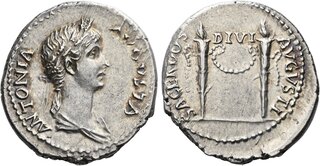| Numismatica Ars Classica > Auction 143 | Auction date: 7 May 2024 |
| Lot number: 491 Price realized: This lot is for sale in an upcoming auction - Bid on this lot  | Show similar lots on CoinArchives Find similar lots in upcoming auctions on |
| Lot description: The Dioscuri Collection. The Roman Empire. In the name of Antonia, wife of Nero Claudius Drusus. Denarius 41-42, AR 20 mm, 3.69 g. ANTONIA – AVGVSTA Draped bust of Antonia r., wearing barley wreath, hair falling down neck in plait. Rev. SACERDOS – DIVI – AVGVSTI Two burning torches decorated with garland. C 5. BMC Claudius 114. Giard 61, 29. Trillmich 20, 24. Von Kaenel 63, type 15. RIC Claudius 68. CBN 18 (Lugdunum). Very rare and in exceptional condition for the issue, undoubtedly among the finest specimens known. A lovely portrait of fine style and a delightful light iridescent tone, good extremely fine Ex Tkalec 29 February 2000, 240; M&M 92, 2002, 36 and NAC 80, 2014, 56 sales. All of the coins which Claudius struck for his deceased mother Antonia honour her as Augusta, a status she shared only with Livia. We are told by Suetonius (Gaius 15) that Caligula compelled the senate to grant Antonia every honour possessed by Livia. However, the same historian (Claudius 11) tells us she refused what Caligula proposed and that only after her death was she hailed Augusta by Claudius. (It is worth noting that an inscription from Corinth indicates she was hailed Augusta by Caligula.). Antonia's portrait on the obverse of her two precious metal coinages represent her in the guise of Ceres (Demeter), for she wears a crown of grain ears. The reverse type of this denarius is inscribed SACERDOS DIVI AVGVSTI, and depicts two alight torches linked by a ribbon or garland. The inscription is a direct reference to Claudius – the issuer of the coin – as the priest of the cult of Divus Augustus. The meaning of the two torches is less clear. Perhaps they signify Livia and Antonia as the only two women, both deceased, who held the title Augusta. Alternatively, they may represent the rites of the Augustan priesthood, of which Antonia was named priestess under Caligula, and Claudius since the accession of Tiberius. Equally likely is the possibility of the explanation involving the Ceres-Demeter connection already noted for the obverse. Demeter is usually depicted holding a torch, which illuminated her visits to the underworld. The worship of Ceres-Demeter in Rome involved annual celebrations (the Cerealia) and games (the Ludi Cereales). The cult was ancient and important, and was inextricably tied to the Eleusinian Mysteries. Claudius' interest in its occult rituals must have been deep since Suetonius (Claudius 25) tells us he tried to relocate the Eleusinian Mysteries from Attica to Rome. Estimate: 12500 CHF |  |



